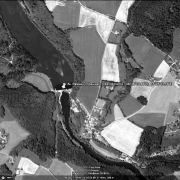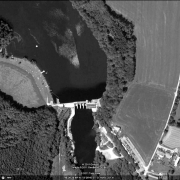Satellite Camp Passau I
Gründung des Konzentrationslagers
In 1939, the city of Passau acquired the Oberilzmühle (mill), in order to build a hydraulic power station in addition to the existing Ilz power plant in Hals. In May 1942, the project was handed over to the “Arno-Fischer Forschungsstätte” (Research station), who was planning on building a so-called underwater power plant under the supervision of Arno Fischer. On 19 October 1942, Passau I - Oberilzmühle Subcamp was established as a subcamp to Dachau Concentration Camp, and about one month after that, Mauthausen Concentration Camp took over its management.
Lokalisierung
The construction site and the camp were about 5 km north of Passau, near the river Ilz; finding the exact location of the camp today is no longer possible.
Informationen über die Häftlinge
When Passau I was established, 24 prisoners that were predominantly categorised as “political prisoners” and had been moved to Passau from Dachau were detained there. This group was replaced in 1943 by 70-80 prisoners from Mauthausen Concentration Camp. They came mainly from Poland, but also Spain, Czechoslovakia, German, the Soviet Union, and Austria. In September 1944, 70 male prisoners were at the camp. In February 1945, 50 prisoners were transferred to Mauthausen Concentration Camp.
Zwangsarbeit
Some of the prisoners had to work at Oberilzmühle sawmill and do general clean-up works after bombings by the allied forces. Others had to get rid of dud bombs. The majority of the prisoners, however, had to work at the construction site of the underwater power plant. After most of the prisoners were transferred to Mauthausen in February 1945 (50 persons), the remaining 20 prisoners had to do assembly and maintenance work of the completed parts of the plant until the end of the war.
Bewachung
The guards were eight, and later fifteen, SS soldiers. Violence and severe physical abuse by the guards were very common at Passau I; the deaths of (at least) four prisoners are documented.
Schließung
The camp was shut down by the camp leader shortly before the arrival of the US Army. On 2 May 1945, the US Army found the prisoners, who had been left to their own devices, at the camp.
Gedenken und Erinnern
After the war, the unfinished underwater power plant was converted into a conventional hydraulic power station. A memorial plaque was mounted to the dam wall.


